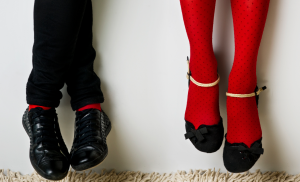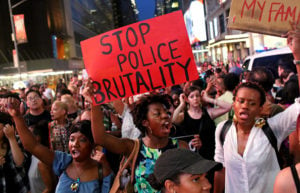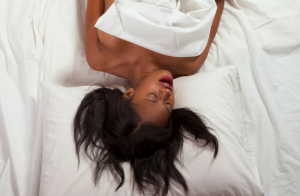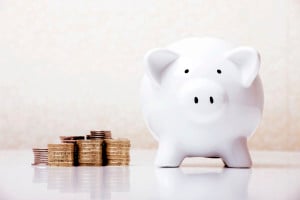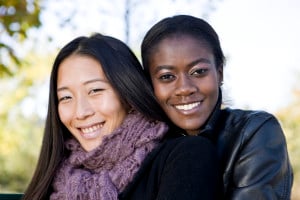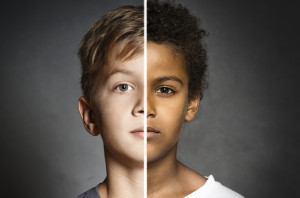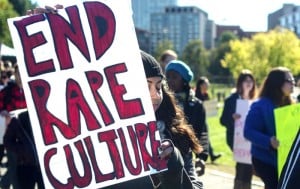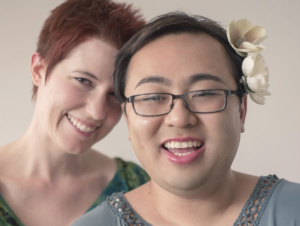Back in the day, when I identified as a lesbian and didn’t yet know to use they/them gender pronouns for myself, my girlfriend and I would inevitably get the same questions from friends, family, and strangers:
“If y’all get married, which one of you is wearing the dress?”
“Who wears the pants in your relationship?”
“Who’s the man in your relationship?”
My response to these questions was almost always the same – a strained smile and a sarcastic “Well, we’re both women, so…”
Regardless of the intentions behind these types of questions, here’s what I interpreted: The only way that my queer relationship could work or be seen as valid is if it models a heterosexual relationship, complete with the sort of gender roles where only one person “wears the pants.”
Most of the time, I push back against this messaging. But by the time I came out (the first time), I had spent so long caring about what was expected of me that I refused to live in silence and shame any more.
Queerness was and is, for me, as much a political identity as it was about my gender and sexuality. It was not about reflecting a heterosexual relationship or about fitting into any societal norms that felt restricting or inauthentic to me.
That being said, pushing back takes a lot of energy.
Even though I did my best to ignore those expectations and maintain whatever dynamics felt good to my partners and I at the time, I still struggled with the pressures of gender performance that is reinforced both within mainstream society and internalized within the LGBTQIA+ community.
And I still struggle with it – even to this day.
As a non-binary, masculine of center person, I find myself pulling out my credit card by default while on dates, opening doors, feeling pressures to dress and behave in certain ways. Because that is what is expected of me.
And while there is nothing wrong with, for example, the conscious and consenting decision for me to pay for dinner, so much of that unconscious behavior is rooted in greater systems of heterosexism and misogyny.
To be clear, I love all of the diverse ways that gender manages to show up and feel good and liberating, but I also want us (queer and trans folks) to think more about how some of those gendered behaviors, especially when unchecked, can be harmful and problematic.
Are we limiting ourselves and our love according to who we’ve been taught we should be attracted to, and what roles we should play in romance? Are we projecting our expectations onto others about how they should behave?
Even when we are comfortable and happy fitting into heteronormative gender expectations in our partnerships, have we reflected on how our behaviors may be unconsciously perpetuating internalized heteronormativity and sexism?
As queer people, when we don’t examine how internalized oppression is operating in our communities, friendships, and partnerships, we may be perpetuating some of the same systems that we are fighting against.
‘I Ain’t Got No Type!’ – The Importance of Saving Room for Fluidity
I identify as genderqueer and masculine of center, and in that, it has never been expected that I pursue, date, love, or hook up with someone who identifies and presents similarly.
Mainstream, heterosexist, and transphobic culture tells us that, in intimate relationships, there must be a “balance” of masculine and feminine, of “opposites.”
That’s just the natural order of things.
Except when it isn’t.
In a recent discussion with a friend, I was asked what my type was, and, more specifically, “You would get down with masculine of center folks?”
Without hesitating, I responded, “Oh yeah! I love queer and trans folks of all genders.”
She responded, “Really?” with a surprised smile and asked me to tell her more.
Don’t get me wrong, I used to have more of a “type.” When I was a baby queer whose only example of LGBTQIA+ culture was The L Word, I gravitated more towards femme-identified people and generally did not have attraction for “studs, bois, butches,” and so on.
I more regularly fell into a “protect and provide” role, and this just seemed to be the natural order of things.
“But then!” I told my friend, I met a transmasculine person over one summer who had me falling all over myself and who I felt a dynamic connection with.
This experience not only shattered my preconceived notions about whom I was attracted to and why, it also complicated how and when gender roles and expectations show up in me.
Suddenly, with my summer fling, I found myself instinctively taking more of a passive role, wanting to be protected and held, and dressing in ways that I thought he would be more attracted to (rather than my usual androgynous expression).
Never did he express a desire for me to do so, but I noticed that he was aware of and favorable toward the gender shifts.
My “knight in shining armor” responded with compliments on my looks, and with the game of letting me know he was interested, but not too interested.
When it appeared that he was much more interested in our physical relationship than what I thought or felt, however, I was more ashamed in myself for the performance.
While fluidity in my gender expression is something that I have embraced as natural and just part of being me, the types of performance I have done in intimate partnerships (as one example) are not always who I am.
Internalized ‘Masculinity’ and Misogyny in the Butch/Femme Binary
As I’ve written in of my previous articles, queer culture can have the practice of prioritizing masculinity as the most attractive and desirable gender presentation.
Whether it is the perception of masculine of center folks as “more queer” than feminine folks or the simultaneous silencing of our femme community, queer folks who identify as masculine often carry unconscious power and privilege.
There can be a performance along with queer and trans masculinity, and while it can be beautiful and affirming at times, I have also witnessed it being extremely harmful, misogynist, and femme-phobic.
One of the first things I noticed after I came out and began to innocently browse dating sites like Downelink and the like were the casual uses of words like “bitches” and “sluts” and “hoes” to describe women – and often femmes.
Expectations around appearance (i.e. “no fat or ugly chicks”) and race (“no Blacks or Asians”) and transphobia (“no he-shes or tr*nnies”) are commonplace.
I have had acquaintances look at me sideways when I haven’t laughed along with their joking or have challenged their use of the word “bitch” or their casually cracked jokes about domestic violence.
Internalized misogyny and intimate partner violence are not perpetuated solely by AFAB* butch, masculine of center, stud, and so on folks, but it is most often in spaces with these folks that I have personally experienced this dynamic.
While I have little patience for this type of behavior and language, it shows me on a daily basis how patriarchy, sexism, white supremacy, fatphobia, and transphobia have oppressed queer people enough that we start to do it to ourselves and each other.
And sometimes, it is not our intention to internalize mainstream society’s messaging about masculinity and femininity or how those of us who identify with masculinity should perform in relationships.
Most of us haven’t grown up seeing models of different types of relationships structures and roles, and we might be behaving this way to survive, to fit in with our friends and family.
I mean, for some of us, being queer in and of itself is hard enough, so we do our best to fit into other expectations, to swim the stream so many have swam before.
This type of performance may be safer for some of us, and that’s hella real.
And yet, our lovers, friends, community, as well as ourselves, deserve more.
We (masculine of center folks, in this instance) need to recognize the privilege and internalized sexism we are capable of bringing into our relationships – intimate or otherwise.
How valuable is “masculinity” as a queer identity if it involves the oppressing and silencing of women and feminine people?
It is not only the more overt examples that need to be challenged and examined, but also the more day-to-day actions that I earlier described and sometimes struggle with myself.
To this day, I still find myself instinctually participating in those gender roles I discussed. And just the other night, in fact, I found myself pulling out my card to pay for dinner before I even realized what caused me to do it.
The person I was with identifies as a queer, cis woman, and this almost always is my instinctive behavior – it’s funny how much I have thought about my own internalized “masculinity” and sexism so much, yet still default to so-called chivalry!
Just as I was ready to throw down my card, I paused, looked at her, and asked, “Is it actually okay with you if I pay for this?”
And it was, but often the unconscious decision of “who pays for dinner” comes from long-held sexist beliefs that women and feminine people are not capable of providing for themselves, that they need to be taken care of; and that men and masculine people are expected to be the protectors, providers, controllers, and primary decision makers in intimate relationships.
***
One of the things I have loved most about being unapologetically queer is that I have the freedom and self-determination in how I “show up.”
Both outside and inside of intimate relationships, I have found myself challenging traditional notions of gender performance and roles. It’s an everyday struggle, but I am much happier and able to exist without the confines of labels.
When we in the LGBTQIA+ community (consciously or unconsciously) participate in gender dynamics (i.e. butch/femme binary) and expect certain behaviors to hall in line with one another’s gender, we may be putting ourselves and others into boxes.
My point here is not to discourage identifying with a label that feels good to us – rather, to encourage reflection on what types of expectations we attach to those labels.
We, of course, should be attracted to who we are attracted to, but we also need to think about what systems are at play in our attraction.
We can then begin to free ourselves from some of the expectations of heteronormativity, sexism, transphobia, and other isms that influence who turns us on and who pays for dinner.
After all, from my perspective, it is not my proximity to heterosexual relationships or binary gender roles that makes me queer – it is my challenging of oppression and allowing myself fluidity to disrupt the system.
[do_widget id=”text-101″]
Michal “MJ” Jones is a Contributing Writer for Everyday Feminism and is an awkward, Black, non-binary queer educator, activist, and musician writing to you from Oakland, CA. They earned their BA in Sociology from Sonoma State University, and went on to earn an MA in Student Development Administration from Seattle University and remain committed to improving access and retention to higher education. Listen to their music or read more of their work. Follow them on Twitter @JustSayMJ and read their Everyday Feminism articles here.
Search our 3000+ articles!
Read our articles about:
Our online racial justice training
Used by hundreds of universities, non-profits, and businesses.
Click to learn more


